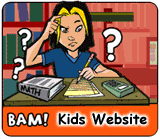Activities
See the Activity Component Descriptions for detailed information on major sections in each of the BAM! activities.
- Body Image
- If Those Dolls Were Real People?
Students take measurements of a favorite category of children's toysÑaction figures and fashion dolls. They'll use ratios to chart what those action figures and fashion dolls would look like if they were the height of an average U.S. man or woman. They will then discuss what effect they think toys like these might have on a young child's perspective of what is normal, and how this may affect mental and physical health. - Ad Decoder
Students take a quick oral quiz on television, advertising, and body image. Then they use an "Ad Decoder" (critical questions) to examine advertisements that are aimed at them. They also discuss how messages about body image can affect health.
- If Those Dolls Were Real People?
- Energy
In this activity, students review the components of the Energy Equation: Food + Sleep + Physical Activity = Energy. They think about the barriers to and benefits of acting on each component of the equation. Finally, students develop a plan for putting their health knowledge into practice. - Epidemiology - Infectious Disease Epidemiology Module
- Natural Disasters
- Are You At Risk?
Working with students so they accurately assess their risk of natural disasters, understand the nature of media coverage of these events, and develop an emergency preparedness plan can help them reframe the problem and reduce their stress. - Helping Hands
Students research the types of diseases and health crises that frequently arise in the wake of a natural disaster, with special focus on disasters in the United States that cause flooding.
- Are You At Risk?
- Physical Activity
- Start here first:
Answer pre-assessment questions to determine which physical activity lessons to complete with your students. - Active or Not, Here it Comes!
The goal of this activity is to expand students' understanding of physical activity beyond organized sports. - Planning for Physical Activity
The purpose of this activity is to put students in the frame of mind for developing short- and long-term physical activity plans with the objective of providing a sense of competence and positive self-image, as well as setting life-long patterns of physical activity. - How Much Is Enough?
The purpose of this activity is to allow students to summarize the types of physical activity that they have been engaged in, whether they are meeting personal goals, and whether they are meeting the recommended physical activity guidelines.
- Start here first:
- Safety
In this activity, students explore causes of injuries and deaths for kids in their age group. - Smoking
In this lesson, students conduct an experiment that demonstrates what goes into a person's lungs with each puff of a cigarette. - Stress
- The Big Test: How We Experience Short-Term Stress
In this activity, teachers will induce mild stress in students by announcing they are about to have a quiz that will be a major part of their grade. Once students learn that this is not true, they will describe their physical and mental changes in response to this stress. - The Body-Mind Connection of Stress
In this activity, students will fill out their own "physical reactions to stress" inventory and graph the class results. Then they will work in pairs to learn more about the body mechanisms that cause physiological stress symptoms, such as a fast heartbeat, cold hands, and dry mouth, or even longer-lasting symptoms such as a headache and sleeplessness. Finally, students will discuss their own reactions to stress and understand that many physiological stress reactions are part of the body's normal functioning. Students will also look at ways of dealing with stress. - Feeling Frazzled? Stress and What to Do About It
In this activity, students discuss what's bad and good about stress and some of the biggest stressors for kids their age. In a class discussion, students learn more about the differences between short- and long-term stress. They keep a stress diary, and evaluate whether their methods for reducing stress were successful.
- The Big Test: How We Experience Short-Term Stress
- Page last reviewed: May 9, 2015
- Page last updated: May 9, 2015
- Content source:



 ShareCompartir
ShareCompartir